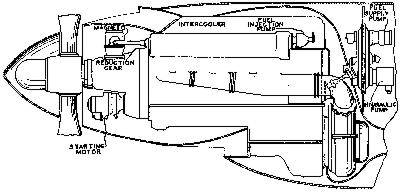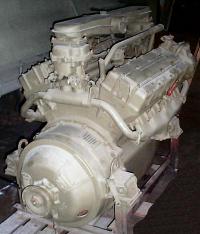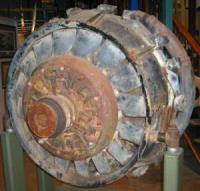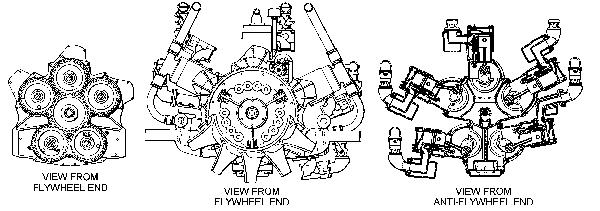

Aircraft Engines in Armored Vehicles
As military planners began to realize the need for armored vehicles prior to World War II, they were faced with the problem of powering such vehicles. The requirements were, aside from the weight issue, similar to those of aircraft—the engines needed to be compact, powerful, reliable and economical to operate.
The use of aircraft engines in tanks was not a new idea. The V-12 Liberty from World War I developed Liberty 338 hp @ 1,400 rpm. Starting in 1920, it powered the Mk. VIII of which (100) were built.
The Continental R-670 first flew in 1931. In addition to its uses in aircraft, it became an extremely popular tank engine. It was a 7-cylinder radial that developed between 235 hp @ 2,400 rpm and 250 hp @ 2,400 rpm when used in armored vehicles. It powered the M1 (89), M1A1 (17), M1A2 (89), M2A1 (19), M2A2 (237), M2A3 (237), M2A4 (375), M3 (4,526), M3A1 (4,410), M3A3 (3,427), Turreted M1 (16), Barbette M1 (3), LVT2 (2,963), LVT(A)1 (509), LVT(A)2 (450), LVT4 (8,348), LVT(A)4 (1,890), and LVT(A)5 (269) (the number produced appears in parentheses after the designation).
Guiberson T-1020 was a 9-cylinder radial diesel was flight tested in a Stinson Reliant in 1940. In tank service it produced 245 hp @ 2,200 rpm and powered the M1A1E1 (7), M2 (34) and M3 Diesel (1,285).
Ford Motor Company thought it would be easier to produce an aircraft engine of its own design than to license-build the Rolls-Royce Merlin. A revolutionary and innovative 60° V-12 was designed and built, but before it could be fully developed, the US became involved in World War II. Ford removed four of the cylinders, resulting in a 60° V-8 for tank use that developed 450 hp @ 2,600 rpm. Several variants were produced.
 |
 |
| Ford V-12 Aircraft Engine Concept | Ford GAA Tank Engine |
Lycoming converted and aircraft engine to produce the O-435T, a 6-cylinder horizontally-opposed air-cooled engine. Used in the M22 Locust (830), it produced 162 hp @ 2,800 rpm.
A distant cousin of the J-5 Whirlwind that took Charles Lindbergh from New York to Paris, the 9-cylinder radial Wright R-975 variations developed between 340 hp @ 2,400 rpm and 400 hp @ 2,400 rpm. It powered the M2 (18), M2A1 (94), M3 (4,724), M3A1 (300), M3A2 (12), M3A5 (591), M4A1 (6,281), M4 (6,748), M4A1(76)W (3,246), M4(105) (800), M7 (7), M39 (640), M44 (6), M4A1(76)W HVSS, M4(105) HVSS (841), M18 (2,507), and M7 (3,490). Many R-975s were built under license by Continental.
 |
 |
 |
| Wright R-975, Accessory End |
Wright R-975, Flywheel End |
Wright R-975 Factory Photo with Cooling Fan Removed |
Wright’s big R-1820 found limited use in armored vehicles in two forms. The G200 was a 9-cylinder gas-burning radial that developed 900 hp @ 2,300 rpm and powered the M6 (8), M6A1 (12). The Wright RD-1820 was converted to a diesel by Caterpillar and produced 450 hp @ 2,000 rpm in the M4A6 (75).
In addition to the use of aircraft engines, several manufacturers geared together multiple automobile engines to get the required power.
Cadillac built a 16-cylinder two V-8s. It developed 220 hp @ 3,400 rpm and powered the M24 (4,371), M5 (2,074), M5A1 (6,810), LVT3 (2,962), M8 (1,778), M37 (150), M19 (300) and M19A1.
Chrysler produced the A57 by combining five 6-cylinder in-lines for a total of 30 cylinders! The engine developed 370 hp @ 2,850 crankshaft rpm and was used in the M3A4 (109) and M4A4 (7,499).
 |
| The Chrysler A57 combined five 6-cylinder in-line engines. |
 |
 |
 |
Much of the data about these engines comes from the Armored Fighting Vehicle web site.
Be sure to read the Rolls-Royce Meteor tank engine book review.